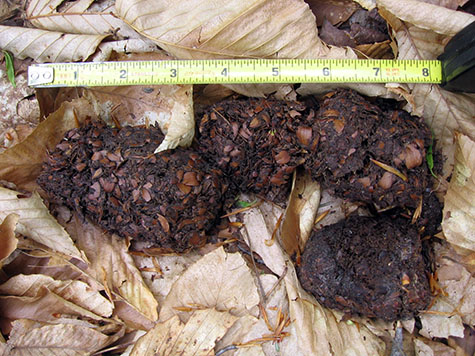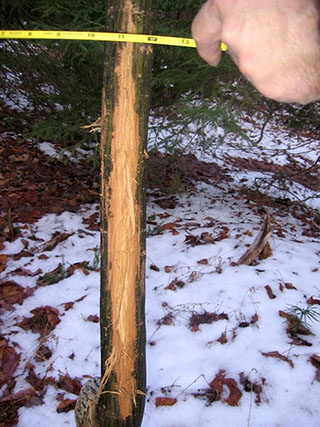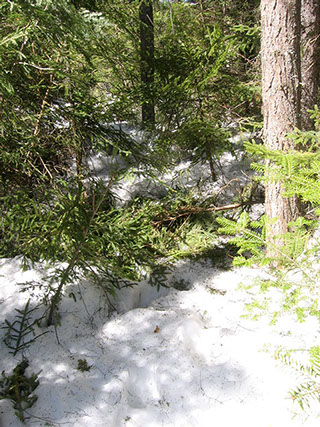
A Tracker's
TRAIL
Overview of Curriculum
Trailing Wildlife is divided into four parts, based on the student’s ability: Introductory (the Trailing section of this website), Beginner, Intermediate, and Advanced. The Introductory section provides a taste of the overall curriculum and helps you to locate a trailing site. The Beginner section is about learning the basics of following trails. The Intermediate section is about learning the basics of assessing a trail's age. The Advanced section is about learning when and how to approach so that you can see the animal.
By the end of the Introductory section of Trailing Wildlife, you should:
- Have a convenient site where you can reliably find and follow a wild ungulate’s trails for 30-60 minutes at a time
By the end of the Beginner section of Trailing Wildlife, you should:
- Have at least one additional site, perhaps less convenient, where you can trail wild ungulates and other animals in either 1) a different substrate or 2) a different habitat, relative to humans (more like wilderness or more suburban, for example)
- Be confident in your ability to identify the maker of the trails you usually follow












Black bear scat.
Bobcat and raccoon tracks on a riverbank.
White-tailed deer antler rub.
White-tailed deer scat.
White-tailed deer track in Beech leaves.
Moose track in moss.
1 - 6
<
>
- Be able to recognize in the trail when the animal was and was not moving in its natural rhythm (its “baseline gait”)
- Be able to use weather sequencing to estimate the age of tracks and
- Have a fair understanding of how fresh tracks look different from old tracks if recent weather has been the same
- Be able to move along a trail and pay attention to the broader environment at the same time
- Have ideas about where to look for the trail when you “run out” of tracks
- Have basic ideas about how and where to look for productive tracking sites
- Have a sense of a trailing practice that you can reasonably do and goals that you can reasonably meet
- Probably have followed at least 50 trails for at least 25 yards each in a variety of substrates
By the end of the Intermediate section, you should additionally:
- Have a site where you can trail the largest wild ungulate in your region
- Be able to anticipate what trails in the field will look like based on recent weather and current conditions
- Have greater clarity about the age of tracks and sign, including scat, broken twigs, crushed leaves, browsed vegetation
- Have familiarity with bird alarms and what they might indicate in the environment around you
- Have experience of rhythm and momentum in how you follow a trail
- Have a better memory for landscape features and be better able to locate them when you need to
- Be able to tell from the track patterns when an animal has sped up and slowed down, even when it is not running
- Have improved ability to see tracks in difficult and very difficult substrate
- Be better able to anticipate when you will find feeding sign and where
- Know when you have spooked the animal you have been following
- Know some options for what to do after you’ve spooked the animal
- Have a fair sense of the animal’s preferred areas in your tracking spots
- Have strategies for dealing with frustrating trails












Two Gray Fox tracks, the more recent at right.
Two white-tailed deer tracks, the more recent at left.
A black bear stood and rubbed its back on this tree.
Bobcat sit spot showing 4 tracks and hind heels.
Tracks of a Coyote in its natural rhythm.
Moose bed.
6 - 6
<
>
- Be better able to distinguish the tracks of individuals that moved in a group of animals
- Be better able to anticipate the locations of beds
- Have better awareness of your environment as you move along the trail
- Have followed approximately 75 more trails, probably totaling a distance of at least 10 miles
By the end of the Advanced section, you should additionally:
- Be able to recognize trail conditions that indicate that the trail is extremely fresh
- Be able to identify a running gait based on a single track
- Know strategies for approaching the quarry without it being aware of you even if you have previously spooked it












Black bear bed on a broken spruce sapling.
Tracks of Bobcat mother and kitten on a riverbank.
Bobcat scrape and scent post.
White-tailed deer feeding sign on acorns.
White-tailed deer track.
A black bear in its den.
6 - 6
<
>
- Have a greater awareness of wildlife alarms and how to get past them
- Recognize signs of predator/prey relationships on the landscape
- Have improved recognition of fresh trails
- Have improved ability to see the quarry when it is camouflaged by the environment
- Be able to lead people on a trail as well as support someone else who is leading
- Have improved intuition for the movements of wildlife
- Be able to move with momentum even when you cannot see tracks
- Have greater confidence in your ability to discern routes that the quarry did not follow
- Know strategies for making an approach and an exit
- Have improved ability to follow trails in a wide variety of substrates
- Have improved ability to recognize the trail in extremely challenging substrate
- Have an improved sense of where on the landscape it would be easiest for the animal to sense your presence, not just by sight
- Have an improved sense of where animals like to position themselves on the landscape in particular conditions
- Have followed approximately 100 more trails, probably totaling a distance of at least 25 miles
© Nate Harvey, 2015